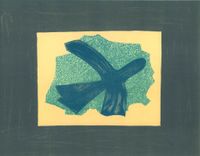Georges Braque was a French painter, collagist, and sculptor best known for his contributions to Fauvism and his pivotal role in the development of Cubism alongside painter Pablo Picasso.
Read MoreBraque was born in Argenteuil, France. He grew up in Le Havre, where his father managed a decorative painting business. Intending to follow in his father's footsteps, the young Braque often helped at the family business, developing an early interest in tactility and texture.
From 1887 to 1899, Braque studied painting in the evenings at the École supérieure d'art et design Le Havre-Rouen, after which he moved to Paris, committed to take on painting as a vocation. There, Braque worked as an apprentice with a master decorator before leaving to paint at the Académie Humbert.
Georges Braque's landscapes and still lifes refine subjects to their basic structures, represented from multiple perspectives at once to convey reality as it is experienced.
Braque's early paintings followed the Fauvist style, inspired by the teachings of Henri Matisse. First shown at the Salon des Indépendants in 1907, colourful works like L'Olivier près de l'Estaque (The Olive Tree near l'Estaque) (1906) depict an arboreal structure in a warm red against a dusty yellow landscape.
An early interest in geometry and perspective can also be noted in works like Maison et arbre (Houses at l'Estaque) (1908), a countryside landscape composed of geometrical shapes, at once three-dimensional and flattened through fragmentation, setting the precedent for cubist experimentations to come.
A 1907 visit to Pablo Picasso's studio, where Braque saw Picasso's Les Demoiselles D'Avignon (1907), paved the way for a long-term collaboration and prompted a departure from Fauvism in favour of more structured compositions.
Following the encounter, the pair gathered daily to discuss and compare works, distilling landscapes into their basic shapes, building towards what would be known as Cubism. Later works incorporated collage and pasted paper elements, as well as sculpture.
Renowned by 1911, the term Cubism was initially introduced by critics who tried to make sense of its 'cubical constructions'. Artists like Fernand Léger, Juan Gris, and André Derain would also contribute to what art historian Ernst Gombrich referred to as a style that would 'stamp out ambiguity' and introduced the reading of a painting as a 'man-made construction.'
When Braque returned from war in 1914, Picasso had turned to figurative painting. Braque's own style became less structured, with an increasing concern for the third dimension, painting many still lifes depicted from multiple perspectives.
The sharp cubical lines from early compositions like the 1911 'Nature Morte' series, or the countless violin, guitar, and female portraits, gave way to softer representations like Rum and Guitar (1918), which retains the geometrical elements without the corresponding harshness.
While these late-1910s works still followed the dictates of Cubism, they foreshadowed the artist's interest in rendering space across different pictorial planes, which led Braque to design costumes and sets for theatre and ballet performances throughout the 1920s.
By 1929, Braque returned to landscape painting, using bright colours borrowed from Picasso and Matisse. Insisting on retaining a physicality in his paintings, Braque produced a series of line studies of Greek heroes and deities, after which he made his 'Vanitas' series, which examined death and suffering.
Objects encountered in Braque's still lifes echoed the artist's mental landscape. These motifs included the recurring appearance of skulls at the onset of World War II, followed by lighter subject matter like flowers and garden chairs once the war ended.
In the 1947 painting Thèiére et Citron, the soft contours of the earth-toned teapot merges with the dark olive of the fruit against an equally sombre yellow backdrop, recalling at once the subject matter of painter and friend Juan Gris and the presentiment of a trajectory's end.
Braque passed away in 1963 in Paris, leaving behind a legacy that consolidated him as a major figure in the development of 20th-century art.
Throughout his career, the artist produced a number of paintings, etchings, graphics, and sculptures, with sustained commitment to expressing the fundamental structures of the object and the physical experience of beauty across volume, movement, and weight.
Georges Braque's works are widely recognised and collected by major museums and institutions worldwide.
Select solo exhibitions include Bernard Jacobson Gallery, London (2021); Nahmad Contemporary, New York (2021); Bucerius Kunst Forum, Hamburg (2020); Portland Museum of Art, Maine (2016); Guggenheim Bilbao, Spain (2014); Museum of Fine Arts, Houston (2014); Galeries Nationales du Grand Palais, Paris (2013); and The Phillips Collection, Washington, D.C. (2013).
Select group exhibitions include Fondation de L'Hermitage, Lausanne (2022); Museum of Fine Arts, Boston (2021); Kunstmuseum Den Haag, The Hague (2020); Museo Picasso Málaga (2020); TEFAF Maastricht (2020); Centre Pompidou, Paris (2018); Albertina Museum, Vienna (2016); and Art Gallery of New South Wales, Sydney (2015).
Braque's paintings, etchings, lithographs, and sculptures are sold by major auction houses worldwide. His most expensive artwork, Paysage à la Ciotat (1907), was sold for US $15.84 million.
Elaine YJ Zheng | Ocula | 2022





